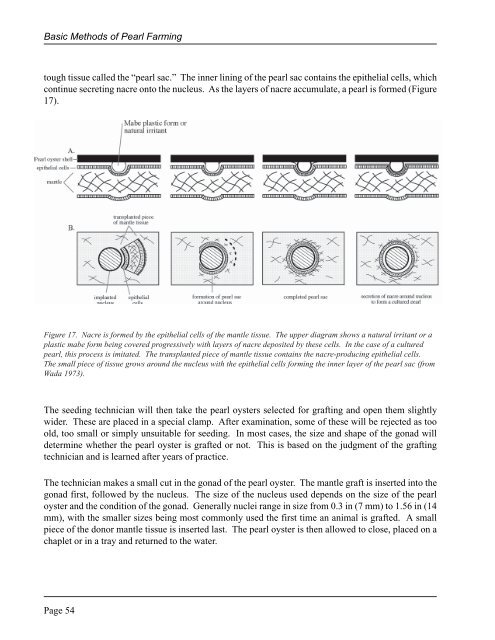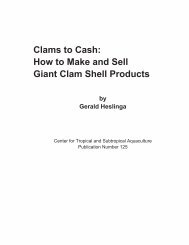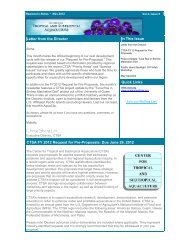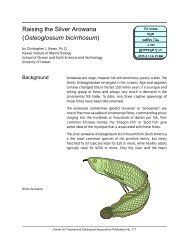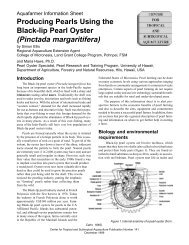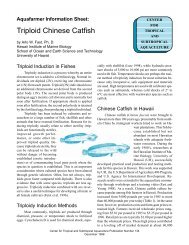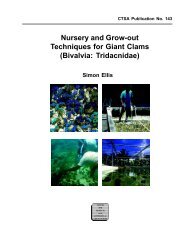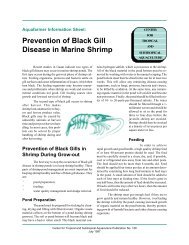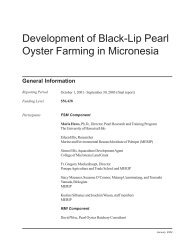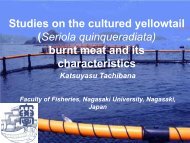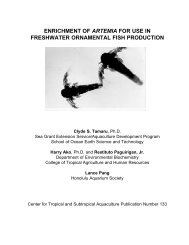The Basic Methods of Pearl Farming: A Layman's Manual - CTSA
The Basic Methods of Pearl Farming: A Layman's Manual - CTSA
The Basic Methods of Pearl Farming: A Layman's Manual - CTSA
You also want an ePaper? Increase the reach of your titles
YUMPU automatically turns print PDFs into web optimized ePapers that Google loves.
<strong>Basic</strong> <strong>Methods</strong> <strong>of</strong> <strong>Pearl</strong> <strong>Farming</strong>tough tissue called the “pearl sac.” <strong>The</strong> inner lining <strong>of</strong> the pearl sac contains the epithelial cells, whichcontinue secreting nacre onto the nucleus. As the layers <strong>of</strong> nacre accumulate, a pearl is formed (Figure17).Figure 17. Nacre is formed by the epithelial cells <strong>of</strong> the mantle tissue. <strong>The</strong> upper diagram shows a natural irritant or aplastic mabe form being covered progressively with layers <strong>of</strong> nacre deposited by these cells. In the case <strong>of</strong> a culturedpearl, this process is imitated. <strong>The</strong> transplanted piece <strong>of</strong> mantle tissue contains the nacre-producing epithelial cells.<strong>The</strong> small piece <strong>of</strong> tissue grows around the nucleus with the epithelial cells forming the inner layer <strong>of</strong> the pearl sac (fromWada 1973).<strong>The</strong> seeding technician will then take the pearl oysters selected for grafting and open them slightlywider. <strong>The</strong>se are placed in a special clamp. After examination, some <strong>of</strong> these will be rejected as tooold, too small or simply unsuitable for seeding. In most cases, the size and shape <strong>of</strong> the gonad willdetermine whether the pearl oyster is grafted or not. This is based on the judgment <strong>of</strong> the graftingtechnician and is learned after years <strong>of</strong> practice.<strong>The</strong> technician makes a small cut in the gonad <strong>of</strong> the pearl oyster. <strong>The</strong> mantle graft is inserted into thegonad first, followed by the nucleus. <strong>The</strong> size <strong>of</strong> the nucleus used depends on the size <strong>of</strong> the pearloyster and the condition <strong>of</strong> the gonad. Generally nuclei range in size from 0.3 in (7 mm) to 1.56 in (14mm), with the smaller sizes being most commonly used the first time an animal is grafted. A smallpiece <strong>of</strong> the donor mantle tissue is inserted last. <strong>The</strong> pearl oyster is then allowed to close, placed on achaplet or in a tray and returned to the water.Page 54


